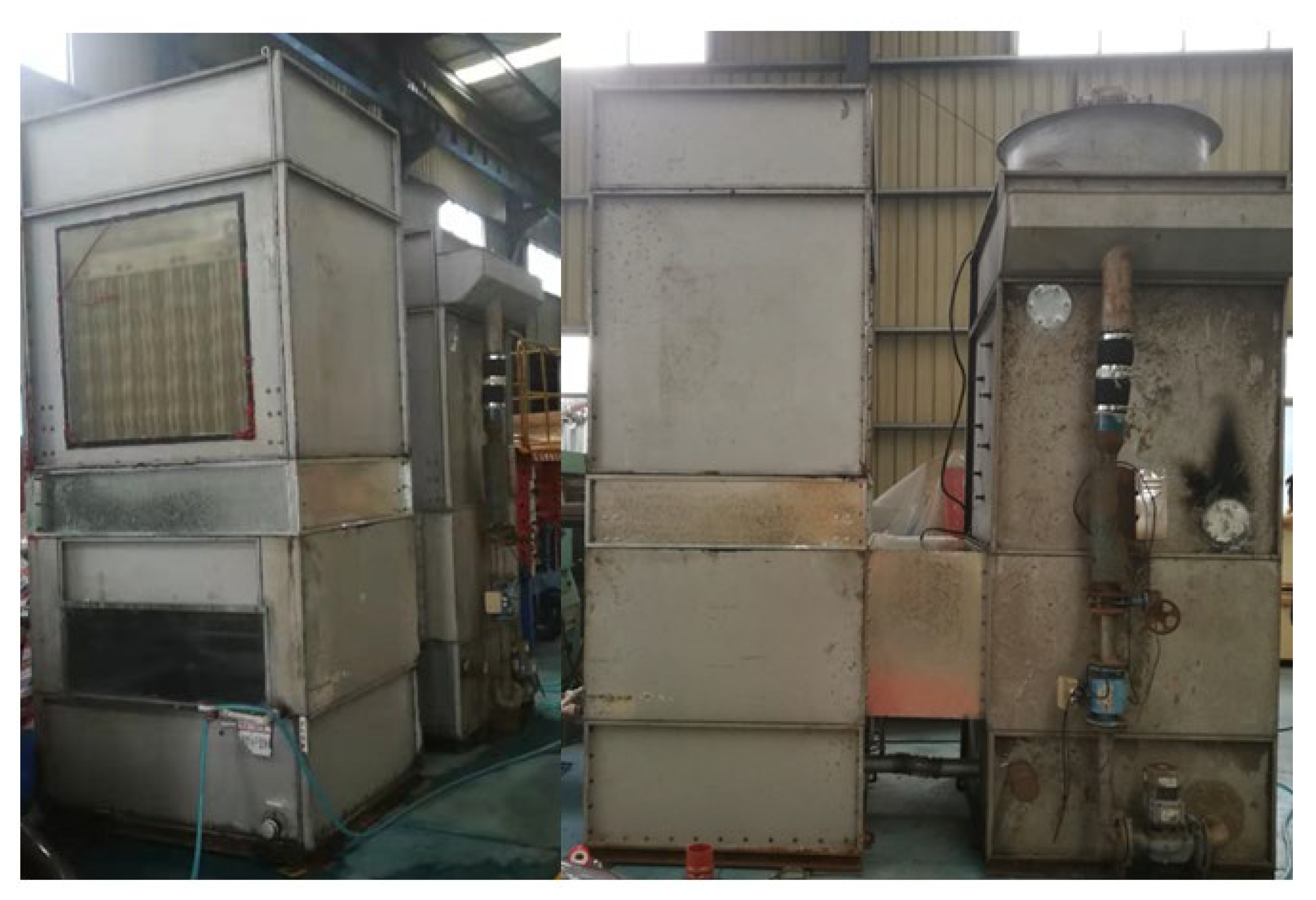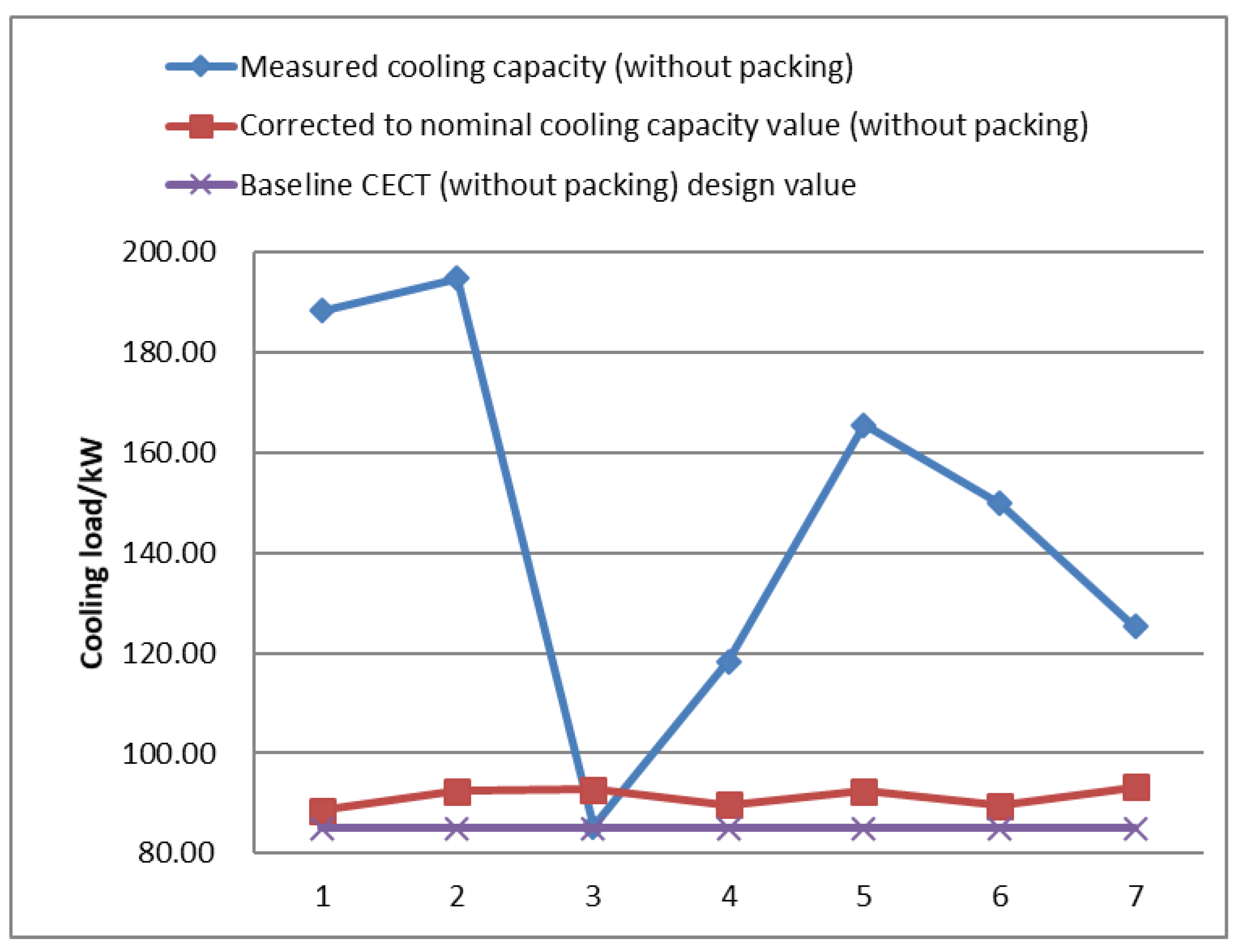Experimental Study of a Novel Non-Packing Closed Evaporative Cooling Tower with Vertical 3D Deformation Tubes
Abstract
1. Introduction
2. Experimental Prototype and Experimental System
3. Data Reduction
3.1. Cooling Load Test and Heat Balance Analysis
3.2. Overall Heat Transfer Coefficients
3.3. Pressure Drop of Hot Water
3.4. Pressure Drop of Air
3.5. Cooling Tower Performance Evaluation and Cooling Load Modification
4. Results and Discussion
5. Conclusions
- (1)
- In the range of the test conditions, the cooling load of the novel CECT increases by 4.1~9.6% with an average increase of 7.31% compared to the previous traditional CECT. Additionally, the convective heat transfer coefficient of the water film outside the tube was increased by 5.87~12.95%.
- (2)
- Compared to the circular, elliptical, and 3D deformation-tube horizontal CECT, the overall heat transfer coefficients of the novel vertical CECT was improved by 35.06%, 18.97%, and 9.45%, respectively.
- (3)
- The heat flux of the vertical CECT decreases by about 7% when the wet bulb temperature increases by 1 °C under the test range of wet bulb temperature, which indicates that the ambient wet bulb temperature has obvious influence on the cooling load.
- (4)
- The main reasons for the improvement in cooling performance for the novel vertical CECT may be that the vertical falling-film evaporation effect and concurrent gas–liquid interface unsaturated evaporation effect of the vertical CECT significantly promote the heat and mass transfer process between the air and water film outside the tube bundle, thus augmenting the cooling load.
Author Contributions
Funding
Data Availability Statement
Conflicts of Interest
References
- Chaurasiya, V.; Chaudhary, R.K.; Awad, M.M.; Singh, J. A numerical study of a moving boundary problem with variable thermal conductivity and temperature-dependent moving PCM under periodic boundary condition. Eur. Phys. J. Plus 2022, 137, 714. [Google Scholar] [CrossRef]
- Chaurasiya, V.; Upadhyay, S.; Rai, K.N.; Singh, J. A new look in heat balance integral method to a two-dimensional Stefan problem with convection. Numer. Heat Transf. Part A Appl. 2022, 82, 529–542. [Google Scholar] [CrossRef]
- Chaurasiya, V.; Singh, J. An analytical study of coupled heat and mass transfer freeze-drying with convection in a porous half body: A moving boundary problem. J. Energy Storage 2022, 55, 105394. [Google Scholar] [CrossRef]
- Parker, R.O.; Treybal, R.E. The heat mass transfer characteristics of evaporative coolers. AIChE Chem. Eng. Prog. Symp. Ser. 1961, 57, 138–149. [Google Scholar]
- Mizushima, T.; Ito, R.; Miyashita, H. Experimental study of evaporative cooler. Int. Chem. Eng. 1967, 7, 727–732. [Google Scholar]
- Hasan, A.; Sirén, K. Performance investigation of plain and finned tube evaporatively cooled heat exchangers. Appl. Therm. Eng. 2003, 23, 325–340. [Google Scholar] [CrossRef]
- Hasan, A.; Sirén, K. Performance investigation of plain circular and oval tube evaporatively cooled heat exchangers. Appl. Therm. Eng. 2004, 24, 777–790. [Google Scholar] [CrossRef]
- Chen, L.; Jiang, B.; Jiang, M.; Feng, Z.; Yang, B.; Liu, Z. Flow pattern criterion and characteristic length of water film outside horizontal tubes. CIESC J. 2010, 61, 15–19. [Google Scholar]
- Gao, M.; Zhang, L.; Yang, M.; Li, Z.; Huang, C.; Huang, J.; Su, Y.; Fan, Z. Experimental study on heat transfer performance outside the tube banks for evaporative cooling. J. Eng. Thermophys. 2008, 4, 640–642. [Google Scholar]
- He, L.; Ouyang, X.; Zhang, L.; Kong, Q.; Huang, C. Experiment on Resistance of Paralle1-flow and Counter-flow in Closed Cooling Tower. J. Refrig. 2010, 5, 48–52. [Google Scholar]
- Harby, K.; Gebaly, D.R.; Koura, N.S.; Hassan, M.S. Performance improvement of vapor compression cooling systems using evaporative condenser: An overview. Renew. Sustain. Energy Rev. 2016, 58, 347–360. [Google Scholar] [CrossRef]
- Zhang, L.-X.; Zhang, C.; Liu, J.-N.; Lin, Z.-H.; Ye, J.; Gao, M.; Shen, Y. Nominal condensing capacity and performance evaluation of evaporative condenser. Appl. Therm. Eng. 2016, 107, 79–85. [Google Scholar] [CrossRef]
- Fiorentino, M.; Starace, G. Experimental investigations on evaporative condensers performance. Energy Procedia 2017, 140, 458–466. [Google Scholar] [CrossRef]
- Xie, X.; He, C.; Zhang, B.; Chen, Q. Counter-Current Gas-Liquid Film Cross-Flow for the Staggered Tube Bundles in Closed Wet Cooling Towers. Chem. Eng. Trans. 2018, 70, 397–402. [Google Scholar]
- Bai, Y.; Zhou, Y.; Zhang, X. Analysis of running performance in winter of closed cooling tower. Build. Energy Environ. 2020, 4, 181–186. [Google Scholar]
- du Plessis, J.; Owen, M. A validated discretized thermal model for application in bare tube evaporative coolers and condensers. Appl. Therm. Eng. 2020, 175, 115407. [Google Scholar] [CrossRef]
- Gong, L.; Zhao, D.; Guo, Y.; Chen, K.; Shen, S. The coupling process of steam condensation and falling film evaporation with non-condensable gas. Int. J. Therm. Sci. 2022, 172, 107201. [Google Scholar] [CrossRef]
- Shan, S.; Tan, H. Study on heat and mass transfer characteristics outside flat tube for evaporative condensers. CIESC J. 2019, 70, 69–78. [Google Scholar]
- Zheng, W.-Y.; Zhu, D.-S.; Song, J.; Zeng, L.-D.; Zhou, H.-J. Experimental and computational analysis of thermal performance of the oval tube closed wet cooling tower. Appl. Therm. Eng. 2012, 35, 233–239. [Google Scholar] [CrossRef]
- Yin, Y.; Zhu, D.; Sun, J.; Li, X.; Tu, A. Experimental investigation of evaporative condensed refrigerating system by variation of heat transfer tube types. Procedia Eng. 2017, 205, 175–182. [Google Scholar] [CrossRef]
- Liu, D.; Zhou, Y.; Li, M.; Sha, Z. Simulation of the cooling tower packing’s thermal performance in closed type cooling tower. Build. Energy Environ. 2009, 4, 14–17. [Google Scholar]
- Zhou, X.; Deng, K.; Jiang, L. Research on performance of evaporative exchanger with combination use of coil and packing layer. Refrig. Air-Cond. 2010, 4, 88–92. [Google Scholar]
- Xie, W. Experimental Research on Heat Transfer Performance of Closed Cooling Tower with Packing Material. Master’s Thesis, Donghua University, Shanghai, China, 2013. [Google Scholar]
- Jian, Q.; Dai, C.; Ren, Q.; Zhang, Y. Analysis on flow field and heat transfer of corrugated filler used in evaporative condenser. J. Refrig. 2014, 3, 90–95. [Google Scholar]
- Ding, X. Theoretical Analysis and Experimental Verification on Cooling Performance of Closed Cooling Tower with Packing. Master’s Thesis, Donghua University, Shanghai, China, 2015. [Google Scholar]
- Wei, J.; Liu, J.; Xu, X.; Ruan, J.; Li, G. Experimental and computational investigation of the thermal performance of a vertical tube evaporative condenser. Appl. Therm. Eng. 2019, 160, 114100. [Google Scholar] [CrossRef]
- Du, L.; Sun, H.; Zhang, J.; Shi, X. Experimental study on heat transfer characteristics of cooling falling film outside a vertical tube in open rack vaporizer. Appl. Therm. Eng. 2020, 172, 115187. [Google Scholar]
- Shen, Y.; Shi, C.; Zhang, L.; Bu, S.; Xu, W.; Zhang, Z.; Zhu, B.; Xu, C.; Liu, X. Falling film evaporation in a vertical tube with a new type of liquid distributor designed using the brachistochrone principle. Vacuum 2021, 187, 110023. [Google Scholar] [CrossRef]
- Bai, H.; Ouyang, X.; Zhao, J.; Li, H. Experiment and performance evaluation of a cross-flow closed cooling tower. J. Eng. Therm. Energy Power 2020, 4, 181–186. [Google Scholar]
- JB/T 11530-2013; Closed Cooling Towers for Refrigeration. Ministry of Industry and Information Technology of the People’s Republic of China: Beijing, China, 2013.
- GB/T 7190.3-2019; Mechanical Ventilation Cooling Tower—Part 3: Closed Cooling Tower. State Administration for Market Regulation, China National Standardization Administration: Beijing, China, 2019.
- Zheng, W. Experimental Investigation and Numerical Simulation of The Heat and Mass Transfer in Evaporative Cooler. Ph.D. Thesis, East China University of Science and Technology, Shanghai, China, 2013. [Google Scholar]
- Zhou, X.; Tu, A.; Zhu, D.; Liang, L. Optimization of industrial evaporative cooler operation with energy and water Saving. J. Refrig. 2008, 6, 36–40. [Google Scholar]









| Item | Instrument Name | Type | Measuring Range | Measuring Accuracy |
|---|---|---|---|---|
| Hot water inlet temperature | Thermocouple | K | −80–400 °C | A |
| Hot water outlet temperature | Thermocouple | K | −80–400 °C | A |
| Hot water flow rate | Electromagnetic flow meter | LDBZB-50S-M2F0 | 0–50 m3/h | 0.5% |
| Spray water temperature | Thermocouple | K | −80–400 °C | A |
| Spray water flow rate | Electromagnetic flow meter | LDBZB-50S-M2F0 | 0–30m3/h | 0.5% |
| Temperature and humidity of air outlet | Hygrometer | XM-AR847 | 5~95%RH −10~80 °C | ±3%RH ±0.5 °C |
| Temperature and humidity of air inlet | Hygrometer | XM-AR847 | 5~95%RH −10~80 °C | ±3%RH ±0.5 °C |
| Air velocity | Anemometer | Testo 417 | 0.3~20 m/s | ±(0.1 m/s + 1.5% Measured value) |
| Atmospheric pressure | Barometer | YM3 | 800~1064 hPa | ±2 hPa |
| Item | Hot Water Flow Volume | Inlet Temperature | Outlet Temperature | Dry Bulb Temperature | Wet Bulb Temperature | Measured Cooling Load | Temperature Difference after Wet Bulb Correction | Cooling Load after Wet Bulb Correction | Nominal Operating Cooling Load | Design Reference Value (without Packing) | Ratio to Horizontal Cooling Load |
|---|---|---|---|---|---|---|---|---|---|---|---|
| t/h | °C | °C | °C | °C | kW | °C | kW | kW | kW | ||
| 1 | 28 | 43.2 | 37.4 | 27.7 | 24.7 | 188.29 | 6 | 156.91 | 88.48 | 85 | 104.10% |
| 2 | 30 | 43.2 | 37.6 | 27.8 | 24.8 | 194.79 | 5.9 | 165.07 | 92.39 | 85 | 108.70% |
| 3 | 32 | 32.2 | 29.9 | 26.6 | 23.1 | 85.34 | 5.7 | 74.86 | 92.80 | 85 | 109.17% |
| 4 | 30 | 35.3 | 31.9 | 26.8 | 23.1 | 118.26 | 5.75 | 102.84 | 89.68 | 85 | 105.51% |
| 5 | 34 | 39.6 | 35.4 | 26.9 | 23.2 | 165.57 | 6.4 | 129.35 | 92.39 | 85 | 108.70% |
| 6 | 34 | 40 | 36.2 | 31.5 | 25.4 | 149.80 | 5.65 | 132.57 | 89.57 | 85 | 105.38% |
| 7 | 30 | 39.3 | 35.7 | 33.7 | 27.3 | 125.22 | 4.8 | 130.44 | 93.17 | 85 | 109.61% |
| Item | Hot Water Flow Volume | Air Flow Volume | Inlet Temperature | Dry Bulb Temperature | Wet Bulb Temperature |
|---|---|---|---|---|---|
| m3/h | kg/s | °C | °C | °C | |
| 1 | 27 | 7.7 | 43.2 | 27.8 | 24.8 |
| 2 | 30 | 7.8 | 39.6 | 26.9 | 23.2 |
| 3 | 35 | 7.6 | 40 | 29.3 | 25.4 |
| 4 | 40 | 7.06 | 39.3 | 31.2 | 27.3 |
| 5 | 45 | 6.24 | 40.6 | 34.4 | 27.4 |
Publisher’s Note: MDPI stays neutral with regard to jurisdictional claims in published maps and institutional affiliations. |
© 2022 by the authors. Licensee MDPI, Basel, Switzerland. This article is an open access article distributed under the terms and conditions of the Creative Commons Attribution (CC BY) license (https://creativecommons.org/licenses/by/4.0/).
Share and Cite
Tu, A.; Liu, S.; Mo, X.; Chen, E.; Zhan, X.; Zhu, D. Experimental Study of a Novel Non-Packing Closed Evaporative Cooling Tower with Vertical 3D Deformation Tubes. Energies 2022, 15, 9336. https://doi.org/10.3390/en15249336
Tu A, Liu S, Mo X, Chen E, Zhan X, Zhu D. Experimental Study of a Novel Non-Packing Closed Evaporative Cooling Tower with Vertical 3D Deformation Tubes. Energies. 2022; 15(24):9336. https://doi.org/10.3390/en15249336
Chicago/Turabian StyleTu, Aimin, Shijie Liu, Xun Mo, Erxiong Chen, Xuefeng Zhan, and Dongsheng Zhu. 2022. "Experimental Study of a Novel Non-Packing Closed Evaporative Cooling Tower with Vertical 3D Deformation Tubes" Energies 15, no. 24: 9336. https://doi.org/10.3390/en15249336
APA StyleTu, A., Liu, S., Mo, X., Chen, E., Zhan, X., & Zhu, D. (2022). Experimental Study of a Novel Non-Packing Closed Evaporative Cooling Tower with Vertical 3D Deformation Tubes. Energies, 15(24), 9336. https://doi.org/10.3390/en15249336





